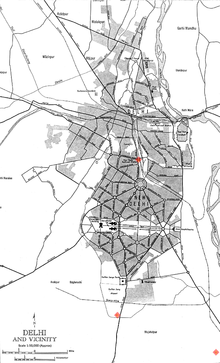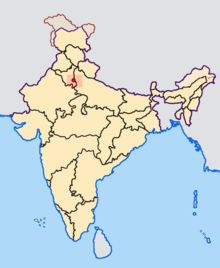2005 Delhi bombings
The 29 October 2005 Delhi bombings occurred on 29 October 2005 in Delhi, India, killing 62 people and injuring at least 210 others[1] in three explosions. The bombings came only two days before the important festival of Diwali, which is celebrated by Hindus, Sikhs, and Jains. The bombs were triggered in two markets in central and south Delhi and in a bus south of the city. Indian investigators believe the Kashmir separatist/ Islamic terrorist group Lashkar-e-Taiba was behind the attacks.
| 2005 Delhi bombings | |
|---|---|
 Delhi map showing the location of the bomb blasts: (1) Pahargunj, (2) Sarojini Nagar market, (3) Govindpuri | |
| Location | Delhi, India |
| Date | 29 October 2005 5:38 pm – 6:05 pm (UTC+5.5) |
| Target | Two markets and a bus |
Attack type | Bombings |
| Deaths | 62 |
| Injured | 210 |
| Perpetrators | Lashkar-e-Taiba |

President A P J Abdul Kalam condemned the blasts in Delhi and sent condolences to the bereaved and other victims. Kalam appealed to the people "to maintain calm and help the agencies in relief and rescue work." Parts of India were moved to higher alert following the blasts.
Timeline
The blasts happened as follows:[2]
- The first blast took place in the main bazaar of Paharganj near the New Delhi Railway Station at around 5:38 pm (IST)*.
- The second blast took place near a bus in Govindpuri area at 6:00 pm (IST)* in the southern part of the city.
- Within minutes of the second explosion, at 6:05 pm (IST)*, the third explosion took place in South Delhi's busy Sarojini Nagar market.
(*Note:IST stands for Indian Standard Time, which is equal to UTC+5.5)
Modus operandi and suspects
- The first explosion (Paharganj explosion) occurred outside New Delhi Railway Station. The explosive device was planted in a two-wheeler (generic term used in India for any motorised vehicle with two wheels, such as a motorcycle or a motorscooter). When the bomb exploded, it ripped apart the M S Medicos, a medical shop outside which the two-wheeler was parked. According to Rediff.com the shop was badly damaged with glass strewn all over the street and blood splattered all over the ground. When the explosion took place large number of people were eating golgappas in the adjoining snacks-cum-sweet shop resulting in the high number of deaths in the area.
- The Govindpuri explosion, which took place inside a bus, injured nine people, four critically. 35–40 people were travelling in the bus when the conductor of the bus spotted a suspicious plastic bag which none of the passengers claimed. The passengers were already suspicious as a man had climbed aboard the bus and refused to buy a ticket, according to the BBC, leaving his large, black bag aboard. The driver and conductor of the bus quickly alerted and disembarked the passengers and, by doing so, minimised the damage when the bomb was thrown out of a window. At the time of the explosion, only five people remained inside the bus. However, the driver and conductor sustained injuries in their rescue effort, and the driver's condition was critical according to NDTV. According to the Indian police, the Govindpuri bomb operated on an electronic timer.
- The third and most devastating explosion took place in a very crowded corner of the busy Sarojini Nagar market. According to The Hindu website, the eyewitnesses claim that the bomb was placed in a white colour Maruti van whose front and rear mirrors were shattered due to the explosion. The bomb went off near a vendor using a gas cylinder, which exploded, triggering multiple explosions and leading to an outbreak of fire in a row of shops. Apart from resulting in the death of 43 people and injuring about another 28 people, half-a-dozen clothing shops and a few vehicles parked behind these shops were destroyed due to this explosion.
- It is believed that the explosive used to carry out the blasts is RDX.
Suspects
The Pakistan-based Islamist terrorist organisation, the Islamic Revolutionary Front or Islamic Inquilab Mahaz, claimed responsibility for the Delhi terrorist attacks. The Mahaz has previous history of terrorism – It was one of the organisations involved in terrorist attacks in the south Pakistan city of Karachi against French, American and other citizens.
The Delhi Police released three sketches of one of the suspected bombers involved in the bombings.[3] According to NDTV, ten suspects have been detained following the blasts. Five of them were picked up from the Delhi Railway station and others from other railway stations and bus terminals.
Tariq Ahmad Dar, was arrested in Kashmir, as the alleged suspect of the attacks on 10 November 2005.[4] The police also arrested the suspected Govindpuri bomber, Mohammed Rafiq Shah.[5] They were freed in Feb 2017 for lack of evidence. [6]
Casualties
Thirty eight people were declared dead in Safdarjang hospital, ten in Lady Hardinge Hospital, five in Ram Manohar Lohia hospital and two in AIIMS. The number of fatalities later rose to 62, with about 210 injured.[1][7]
| 29 October 2005 Delhi bombings Casualties | |||
| Place | Deaths | Injured | Sources |
| Pahargunj blast | 18 | 60 | (Rediff) |
| Sarojini Nagar market blast | 43 | 28 | (Rediff) |
| Govindpuri blast | 0 | 4 | (Rediff) |
| Total | 61 | 92 | |
Rescue and relief operations
Relatives of the dead and injured received money and medical help from the government:
- "Rs 300,000 will be given as ex-gratia to next of the kin of every dead person, while those seriously injured will get Rs 50,000," Delhi Chief Minister Sheila Dikshit told reporters.
- The injured received free treatment at any government hospital.
Reactions
Delhi police ordered all temples and restaurants in Delhi closed shortly after the explosions, and the city of Delhi went on red alert.
Bomb hoaxes
At least two phone calls reporting fake bombs have been received by the Delhi police, including a false report of a bomb in a school (or a fair) for people with visual disabilities. In addition, there was a phone call reporting a (purportedly fake) bomb near a bank in Khari Baoli[8] before the attacks occurred; the object referred to by the call was a suitcase, in which there were documents, batteries, and wires. In the midst of the attacks, there was another hoax call reporting a bomb going off in the Gole Market.
The Delhi police, after the explosions, sent out messages to the public asking them to report unidentified objects. This led to a wave of reports of "bombs", all of which proved to be either nonexistent or more benign objects, including a "bomb" at the Som Bazaar in eastern Delhi and another "bomb" near the Sanjay Gandhi Hospital.
World reaction
The bombings have provoked strong international condemnation from the United States, Britain, Canada, Australia, China, Sri Lanka, Japan, Belgium, Brazil, Iran, UAE, European Union, Bangladesh, Maldives, and South Africa.
See also
- 1993 Mumbai bombings
- List of terrorist incidents
- Allegations of state terrorism committed by Pakistan
References
- "Delhi blasts death toll at 62". Archived from the original on 5 November 2005.
- "Report on Incidents of Terrorism 2005" (PDF). 11 April 2006. Archived from the original (PDF) on 7 July 2006.
- "Delhi blasts: Cops release sketches of suspect". Archived from the original on 20 July 2006.
- "Delhi blast suspect arrested in Kashmir". Rediff.com. 31 December 2004. Retrieved 30 March 2012.
- "2005 blasts: Court seeks accused's call records". The Hindustan Times, 29 October 2007.
- https://www.ndtv.com/india-news/12-years-a-prisoner-man-freed-in-delhi-blast-case-says-i-feel-lucky-1660571
- http://forums.bharat-rakshak.com/search.php?keywords=October+29%2C+2005&t=5427&sf=msgonly
- "2 hours before blast, false alarm at Khari Baoli". Archived from the original on 16 December 2005.